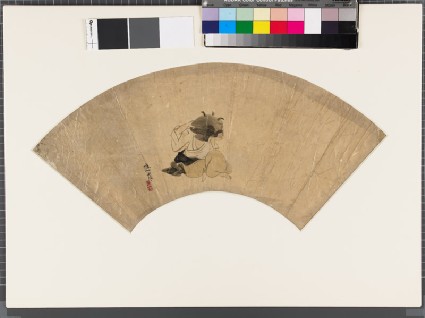Browse: 766 objects
- Reference URL
Actions
The pot-wearing saint
-
Details
- Associated place
-
Asia › Japan › Honshū › Kyōto prefecture › Kyoto (place of creation)
- Date
- probably early 19th century
- Artist/maker
-
Maruyama Ōshin (1790 - 1838) (artist)Maruyama-Shijō School (active late 18th century - late 19th century)
- Associated people
-
Nisshin (1407 - 1488) (subject)
- Material and technique
- ink and colour on paper
- Dimensions
-
mount 40.5 x 55.5 cm (height x width)
painting 23.5 x 48.5 cm (height x width)
- Material index
- Technique index
- Object type index
- No. of items
- 1
- Credit line
- Purchased with the assistance of the Friends of the Ashmolean, and Mr and Mrs J. Hillier, 1973.
- Accession no.
- EA1973.92
-
Further reading
Katz, Janice, Japanese Paintings in the Ashmolean Museum, Oxford, with an introductory essay by Oliver Impey (Oxford: Ashmolean Museum, 2003), no. 21 on p. 90, p. 83, illus. pp. 90-91
Location
-
- currently in research collection
Objects are sometimes moved to a different location. Our object location data is usually updated on a monthly basis. Contact the Jameel Study Centre if you are planning to visit the museum to see a particular object on display, or would like to arrange an appointment to see an object in our reserve collections.
Publications online
-

Japanese Paintings in the Ashmolean Museum
Maruyama Ōshin, Ōju’s son. became the third generation head of the Maruyama school in Kyoto. Little is known of his biography but from a handful of works that exist, it is clear that Ōshin continued the Maruyama school style in figures and kachōga (bird and flower painting) faithfully. This is most notable on sliding doors painted with Farming in the Four Seasons of c. 1830 [see Minamoto and Sasaki, 26-7, 182], part of the decorative programme of the main room of the shoin (study) of Hōkyōji temple. The figures are rendered with gently sloping lines done with a light touch, appropriate to this composition of cheerfully industrious peasants working the land during times of peace. This same figural style is also used for the tortured saint in the Ashmolean’s fan.
In this minimal fan composition, a figure sits trying to remove a kettle from his head. The man is Nisshin (1407-1488), a religious follower of Nichiren (1222-1282). Nichiren founded a sect of Buddhism based on the teachings in the Lotus Sutra alone and began a popular religious movement in which the practitioner need not be trained in the rituals of esoteric Buddhism to achieve salvation. Nisshin’s impassioned chanting of namu-myōhō-renge-kyō (devotion to the glorious true law of the lotus scriptures) was a challenge to Shogun Ashikaga Yoshinori (1394-1441) to accept the true faith. The shogun imprisoned the religious man and among other torments, had a pot placed over the saint’s head in an effort to silence him.
Though Ōshin’s religious beliefs are unknown, many artists and their patrons in Kyoto were Nichiren sect adherents, a sect marginalised throughout its history for its opposition to the shogunal authorities.
© 2013 University of Oxford - Ashmolean Museum

